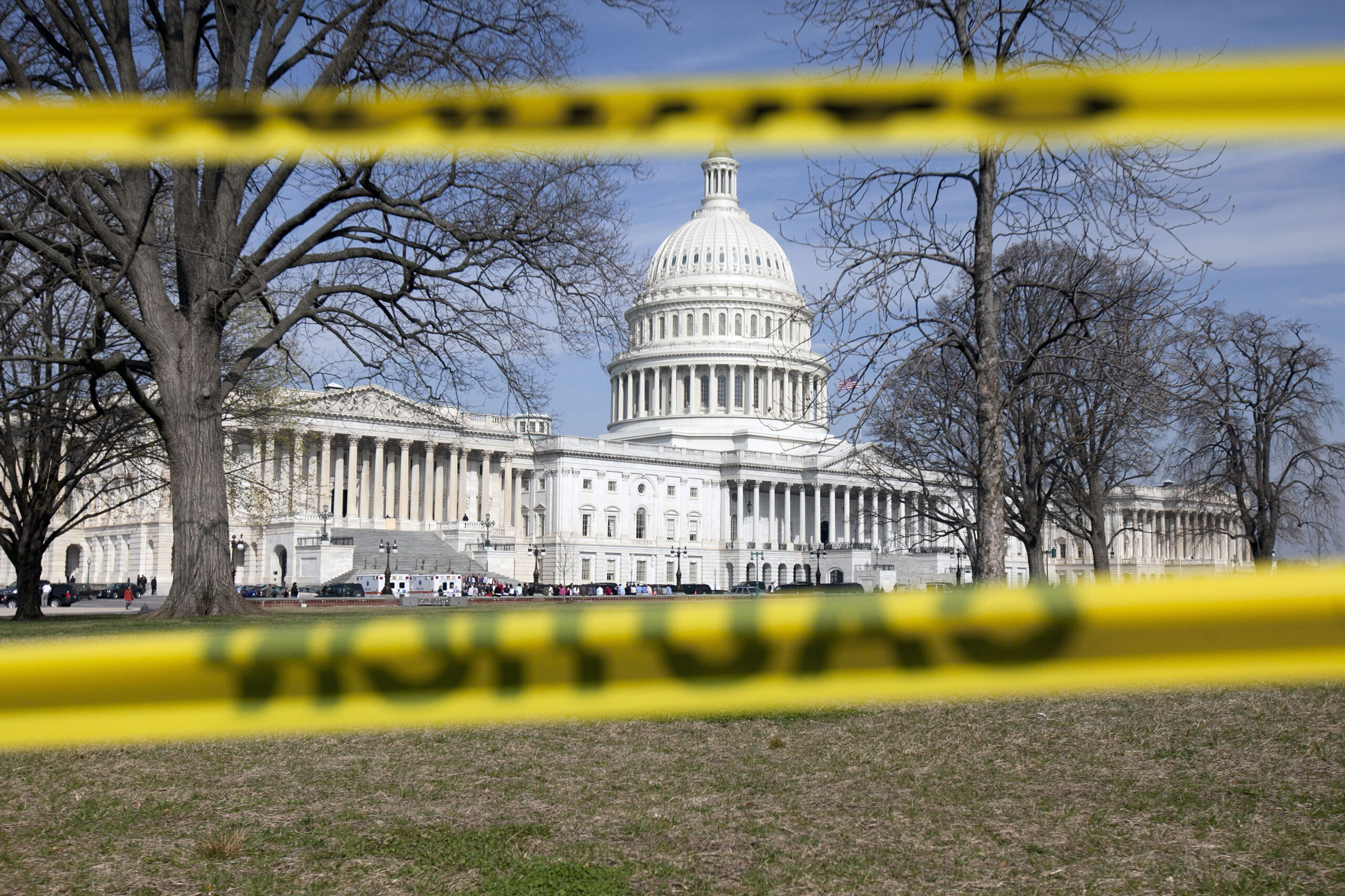An overhaul of the federal bureaucracy needs a media strategy bold enough to sustain it.
A Swing and a Miss

Vivek Ramaswamy makes a valiant but doomed proposal to dismantle the administrative state.
For decades, Republicans have talked about shrinking the federal government by shuttering agencies. Most memorably, Rick Perry at a 2011 primary debate listed the three agencies he would close as president: “Commerce, Education, and…the uh, um, what’s the third one there?”
Rick Perry’s debate performance underwhelmed, but few presidential candidates have done better. Unlike Perry, other candidates may have been able to recall their talking points—promises to abolish the IRS or dismantle the EPA—but they offered no concrete plan to support how they would achieve them.
Today, Republicans are trending in a better direction. Some Republican candidates acknowledge the Deep State and list its reform as a top priority. Republican voters are demanding the same. Now, in this election cycle, Vivek Ramaswamy is going so far as proposing to eliminate entire federal agencies—and articulating how he would do it.
That is a good thing. Ramaswamy has written a white paper that lays out a three-pronged approach to beating back the administrative state, including a plan to eliminate three federal agencies: the Department of Education, FBI, and Nuclear Regulatory Commission. He has laid out a legal strategy of his own invention, and his proposal is substantive, innovative, and creative.
But it will not work.
Ramaswamy’s plan depends on a provision of the 1977 Reorganization Act, 5 U.S.C. 901. This Act begins by setting forth several justifications for its own existence, then it reads: “[t]he President shall from time to time examine the organization of all agencies and shall determine what changes in such organization are necessary.” Ramaswamy claims this provision gives the president the independent power to make changes in the organization of all agencies. Would that it were so.
The first problem is that this provision comes as part of the Act’s statement of Congress’s purposes, a type of precatory statutory provision that creates no enforceable law of its own but merely serves (at most) as an interpretive guide to the rest of the statute in the event its words prove to be ambiguous. Congress’s findings and purposes are part of articulating the “why” behind a statute, not the “what” of it.
In this case, Congress says its purpose is to promote better laws, improve efficiency, reduce expenditures, and so on. It invites the president to evaluate those things from time to time and “determine what changes…are necessary” in the structure of the federal government. That is not enforceable language. It does not obligate nor does it empower the president. Even if it did, it would not empower the president to act unilaterally to restructure the federal government, as Ramaswamy’s interpretation holds. At most, this language invites the president to weigh in with his view of what changes in the structure of the federal government are necessary to effectuate Congress’s stated purposes. He can “determine” what the government needs; he cannot legislate the changes himself.
The second problem is that Ramaswamy’s interpretation reads the Act as a mere fragment, detached from its original context. Read in context, the Act’s original public meaning could not have been to grant the president the unilateral power to reorganize the federal government, as Ramaswamy claims. Ramaswamy knows this because his white paper describes how the Act originally created a “Reorganization Plan” process, the provisions of which have long ago expired.
This is a critical point. In the Act’s Reorganization Plan process, the president could submit a plan for reorganizing the federal government to Congress, and that plan would become effective 60 days later unless one or both houses of Congress acted to disapprove it. The process contained many more strictures and obligations on both the president and Congress, and the process could play out only in a defined three-year time frame. President Carter used the process—to create federal agencies, not eliminate them, and he did so by submitting his plans to Congress, not by going it alone.
It is nonsensical to believe that Congress enacted numerous code sections in 1977 laying out a detailed and cooperative process for reorganizing the federal government, yet simultaneously empowered the president through a single clause to accomplish reorganization unilaterally. Yet that is what Ramaswamy’s interpretation holds, and any court would reject it.
No Time to Waste
The 1977 Reorganization Act is part of a legislative species: a long line of reorganization acts preceded it (beginning with the Reorganization Act of 1939), and two others followed (the Amendments of 1980 and 1984, during President Reagan’s administrations). All of them spelled out a reorganization process that called for both the president’s and Congress’s participation.
Ramaswamy bravely attempts to alleviate this problem, claiming that the expiration of the Reorganization Plan provisions actually strengthens the president’s unilateral authority. He says those provisions gave Congress the power to reject a Reorganization Plan, and without that power to reject, the president is free to act on his own. But Ramaswamy overlooks the fact that the expired provisions also empowered the president to submit a Reorganization Plan to Congress in the first place, and necessarily so, because the U.S. Constitution does not otherwise grant the president the power to organize the Executive Branch. Rather, Congress creates the executive departments and agencies; the president merely carries out those laws.
The really fatal Amendments for Ramaswamy’s theory are those passed in 1980 and 1984, after the 1977 Act had expired. Those Amendments effectively renewed the Reorganization Plan process during the Reagan Administrations. Under Ramaswamy’s reading of the 1977 Act, Congress and President Reagan were engaged in a farce: If Ramaswamy were right, Reagan would have already had the unilateral authority to reorganize the federal government in 1980 and 1984 because of the unexpired clause of the 1977 Act’s purposes provision. The joke is on them, one presumes.
The last problem with Ramaswamy’s reorganization theory is that it is entirely opposed to the one legal doctrine that conservatives have used successfully to restrain the administrative state in recent years: the Major Questions Doctrine. The doctrine’s basic principle is that courts will presume Congress has not delegated the resolution of major political or economic questions to the Executive Branch without a clear statement to that effect. Yet Ramaswamy’s reorganization theory presumes exactly the opposite: it locates a unilateral executive authority to reorganize the federal government in one at-best-ambiguous clause of a dormant statute, contrary to the demands of the U.S. Constitution and the actions of Congress both before and after the clause was enacted. No court could accept Ramaswamy’s theory without rejecting the Major Questions Doctrine.
For Ramaswamy, this legal flaw is an ironic one: another Ramaswamy campaign promise is to reform the administrative state by cutting 75 percent of federal regulation. He proposes to accomplish that through the force of…the Major Questions Doctrine.
Ramaswamy’s plan to reduce the power of the administrative state is creative to say the least, and he deserves credit for deploying it. Few Republican candidates have dared to put forward a plan as specific as his, and more candidates should follow his lead.
But the Ramaswamy plan will not solve the problems of the administrative state, and it would derail any presidential administration that pursued it.
Republicans cannot afford to get this issue wrong and certainly can’t afford to waste time and resources on ideas doomed to fail. In his 1982 State of the Union address, Reagan vowed to close the Department of Education less than three years after Jimmy Carter opened it. Yet 45 years later, the Department of Education not only continues to exist but is leading the campaign to push transgender ideology onto kids, including the destruction of women’s sports and parental rights. Reagan’s failure has become the Republican status quo. The proliferation of the administrative state is our country’s most pressing domestic policy problem because it affects (by distorting) all others. Leading Republican presidential candidates now understand the threat. That is a great victory and a sign of progress. But next, they will have to align behind an actual solution.
The American Mind presents a range of perspectives. Views are writers’ own and do not necessarily represent those of The Claremont Institute.
The American Mind is a publication of the Claremont Institute, a non-profit 501(c)(3) organization, dedicated to restoring the principles of the American Founding to their rightful, preeminent authority in our national life. Interested in supporting our work? Gifts to the Claremont Institute are tax-deductible.
What it will take to break the Deep State.
What it will take to break the Deep State.



